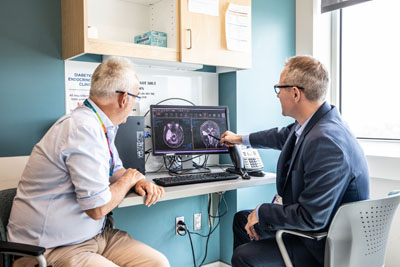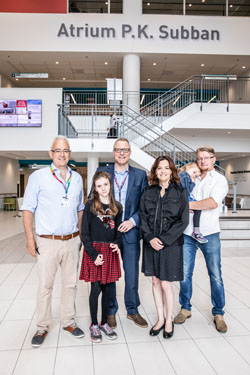
A rare respiratory disease may be more prevalent in Quebec
27 November 2025
Rise in respiratory infections and measles outbreak: important infection prevention measures at the Montreal Children’s Hospital.
Read moreWelcome to the Montreal Children's Hospital

25 June 2019
Catherine Nantel still gets emotional every time she thinks back to May 28, 2015. It was the day her daughter’s life completely changed. Zoé Sankowski was a normal eight-year-old girl before she started having seizures. Her first one was so serious she ended up in the hospital, but it was by no means her last.
A complete nightmare
Zoé was transferred from her local hospital to the Montreal Children’s Hospital Pediatric Intensive Care Unit (PICU) after she began having seizures every 15 minutes. She was placed in an artificial coma for over two weeks while specialists from different departments tried to figure out what was wrong.
Pediatric neurologist, Dr. Guillaume Sébire, Director of the Division of Pediatric Neurology at the Children’s, diagnosed Zoé with autoimmune encephalitis, a condition that occurs when the body’s immune system begins attacking healthy brain cells, thus causing the brain to become inflamed.
The inflammation led to the sudden on-set of aggressive seizures which significantly impacted Zoé’s life. She stopped being able to talk, walk or feed herself. Her parents, Catherine and Norbert, barely recognized their little girl. “It was a complete nightmare,” recalls Catherine. “She didn’t even know who we were anymore.”
 Hitting rock bottom
Hitting rock bottom
Zoé tried treatment after treatment until finally one anti-inflammatory medication seemed to help reduce her seizures. She was discharged from the hospital and started therapy at the Marie-Enfant rehabilitation centre. “She had to relearn how to walk, talk and eat,” says Catherine. “The seizures had left her in a poor developmental and physical state. She was non-verbal for three months, so hearing her start to speak again was unbelievable.”
Over the next six months, Zoé seemed to stabilize, but then she and her parents got more bad news. Zoé’s encephalitis had traveled to her cerebellum, a part of the brain that’s located behind the top part of the brain stem. Then a few months later, she was diagnosed with a second serious (likely autoimmune)condition, called aplastic anemia, a disorder that causes the bone marrow to cut down its production of red and white blood cells, as well as platelets. But the bad news didn’t stop there; her seizures started up again. “Not only did her seizures get worse, but they were now more frequent,” says her mother. “She started falling down every time she had one.”
Dr. Sébire began to think that Zoé was suffering from an underlying issue. “We started to believe that her immune system dysfunction was due to a default in antibody production,” he says, and suggested a new immunoglobulin treatment which targeted the antibodies in her blood in the hopes that they might prevent her body’s immune system from attacking her brain altogether. In combination with the other previously administered anti-inflammatory treatments, the progression of Zoé’s encephalitis stopped, but sadly, it did not decrease her abundant seizures. “At this point, we didn’t know what else to do,” admits Catherine. “We were completely discouraged.”
One last hope
Pediatric neurosurgeon, Dr. Roy Dudley, was then brought in to look into the possibility of resective surgery, where part of the brain is removed to stop the seizures. “At first Zoé didn’t seem like a good candidate for surgery, because her epilepsy was coming from both sides of her brain and we obviously can’t remove both temporal lobes,” explains Dr. Dudley. “But over time, her electroencephalograms (EEGs) began to show a non-active left side and an overactive right side. We decided to run more tests to see if surgery was now an option.”
Zoé underwent an extensive pre-surgical evaluation to determine whether or not she was eligible for surgery and if so, what part of the brain could be removed to stop her seizures. “These tests help us develop a hypothesis about the seizure onset zone, and the borders around it, known together as the epileptogenic zone. We also want to make sure we don’t run the risk of removing part of the brain that could negatively affect speech or memory, or any other important function,” he continues.
After gathering all the data, the results were still not conclusive. Dr. Dudley then suggested implanting stereotaxic depth electrodes into Zoé’s brain, a procedure he plans and performs with world-renowned epileptologist, Dr. François Dubeau, and a team of experts at the Montreal Neurological Institute. “All the pre-surgical tests we ran helped us create a good hypothesis about Zoé’s problem. It suggested that the majority, if not all, of her seizures were coming from the right temporal lobe, but the electrodes would help us confirm this hypothesis,” says Dr. Dudley.
Tiny holes were drilled into Zoé’s skull. Fifteen electrodes were implanted into the right side of her brain, and two on her left. Over the next nine days, Zoé was monitored closely. The electrodes were connected to a video-monitoring machine that fed all her results directly to the EEG lab where technicians reviewed them every 12 hours.
Over the next week, Zoé suffered approximately seven seizures, all from her right side. “It became evident that all her seizures started in the right hippocampus, which is located in the medial temporal lobe of the brain,” affirms Dr. Dudley. At the end of the session, Dr. Dudley was confident that a complete right temporal lobe resection could greatly improve Zoé’s quality of life. Now it was time for her parents to make a big decision.
 Going in for surgery
Going in for surgery
On April 30, 2018, Zoé was wheeled into the Children’s operating room. Over the next five hours, Dr. Dudley and his team removed her entire right temporal lobe. “The left temporal lobe is involved in language and verbal memory processing, whereas the right temporal lobe is responsible for non-verbal skills, like visual and spatial memory,” explains Dr. Dudley. “Amazingly, the brain is able to rewire itself and the left side can compensate for the right side.”
After surgery, Dr. Dudley showed Catherine and Norbert an MRI image of the right side of Zoé’s brain. A big, white empty hole filled with fluid now stared back at them. “We couldn’t believe that our daughter could function with so much of her brain missing,” says Catherine. “But Dr. Dudley explained that Zoé’s right side was so abnormal, it wasn’t functioning properly to begin with.”
Her family quickly noticed a few important changes. Her voice and the speed of her speech had improved, she was more alert, and she seemed physically stronger. Also, most important, her seizures had stopped – for a little while at least. “After a couple of weeks, her seizures started up again, but this time they were coming from the left side,” says Catherine.
Dr. Dudley explained that after resective surgery three things can happen: the patient is cured, the patient is not cured, or the patient experiences a ‘running down’ phenomenon, where the seizures decrease slowly over time. “We believe this is what’s happening to Zoé and hopefully over time, her seizures will stop completely on their own,” says Dr. Dudley.
Today, Zoé is doing extremely well. She has a mild seizure every two to three months, but her parents are amazed by how she’s progressing developmentally and physically. Her language has improved immensely, and she can now read, write and do simple math. She’s also started school again, and recently played in a hockey league for children with special needs. She’s even decided to take up soccer this summer. “Even though Zoé still has the occasional seizure, they are now manageable. She can finally have a life again,” says her mother. “And, we finally feel like we have our daughter back.”